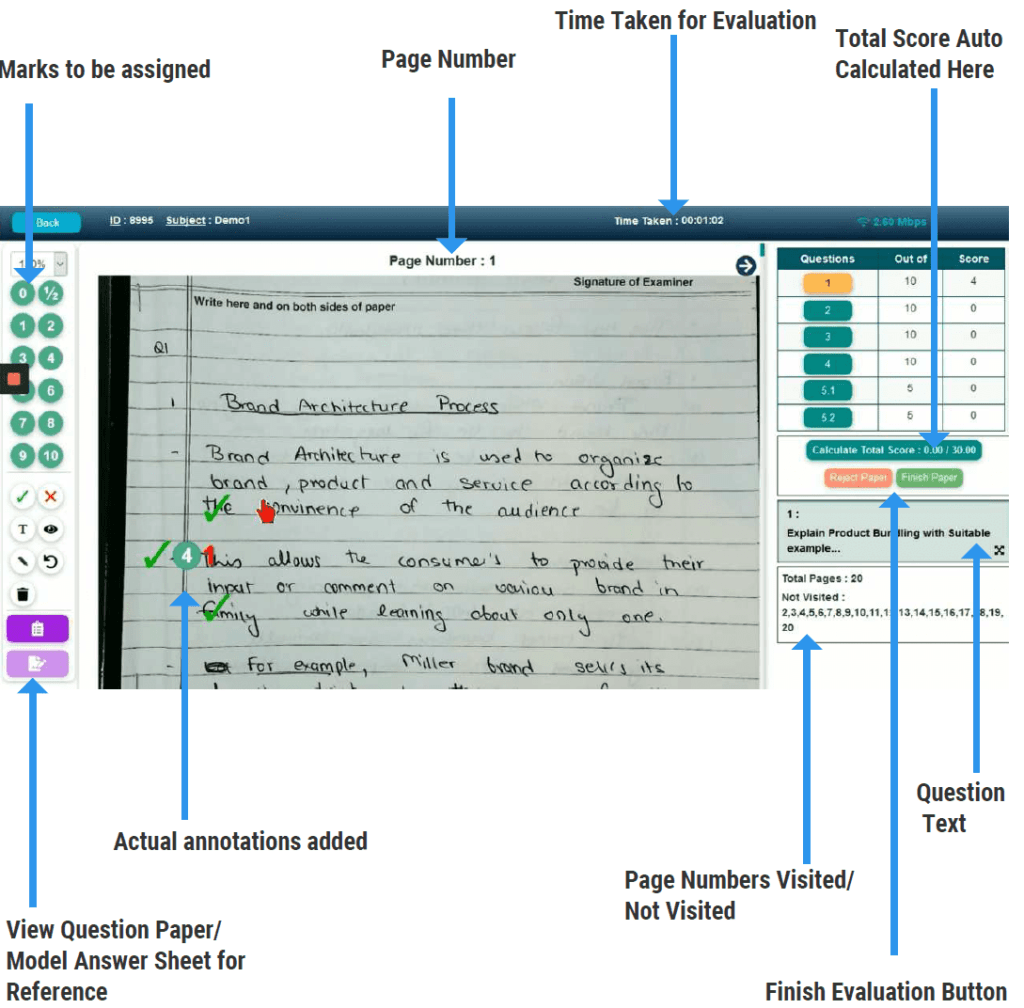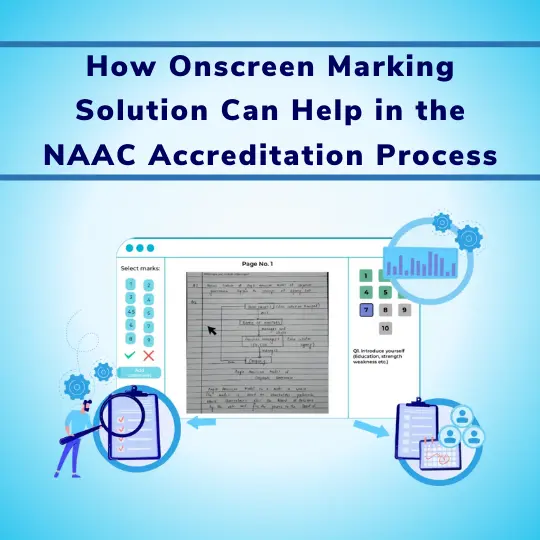Article Contents
Introduction
In today’s world, educational institutions and universities are striving to enhance their NAAC Accreditation ratings.
With the aid of various tools and technologies, it is feasible to boost the overall NAAC accreditation ratings for these establishments. In this regard, NAAC accreditation typically necessitates a variety of reports related to learning outcomes, overall evaluation processes, student performance, batch performance, and examination procedures.
The NAAC accreditation process demands thorough documentation, making manual answer sheet evaluations a potential obstacle to generating these crucial reports.
Thus, implementing an on-screen marking system can significantly improve the operational efficiency of answer sheet evaluations and facilitate the generation of NAAC accreditation-related reports.
In this article, we shall delve into how the NAAC accreditation process can be simplified through the adoption of on-screen marking systems.
NAAC Accreditation
As an educational institution, attracting prospective students through various branding activities is crucial, and a high NAAC accreditation grade is a key aspect that can draw them in. To achieve a higher ranking in terms of NAAC accreditation, it is vital to maintain proper documentation of processes and adhere to the guidelines provided.
NAAC accreditation places significant weight on examination management, evaluation processes, and result processing. If these aspects are well documented and the proper procedures are followed, your institution stands a greater chance of earning higher accreditation from NAAC authorities. Thus, it is an important criterion to consider.
The National Assessment and Accreditation Council (NAAC) plays a pivotal role in ensuring quality assurance and the continuous improvement of higher education institutions in India.
The accreditation process evaluates institutions on several criteria, including curricular aspects, teaching-learning and evaluation, research, consultancy and extension, infrastructure and learning resources, student support and progression, governance, leadership, and management, and innovations and best practices.
This comprehensive evaluation framework ensures that institutions meet the high standards set by NAAC, thereby enhancing their reputation, credibility, and quality of education.
Examination Management for NAAC

A crucial part of the NAAC evaluation focuses on examination management, the evaluation process, and result processing under the broader category of teaching, learning, and evaluation.
This criterion assesses the effectiveness of the institution’s teaching methods, use of technology, and evaluation practices, including how examinations are managed, the transparency and robustness of the evaluation process, and the efficiency of result processing.
Improvements in these areas can significantly contribute to achieving a better NAAC grade, reflecting the institution’s commitment to excellence in education.
Improvements in these areas can significantly contribute to achieving a better NAAC grade, reflecting the institution’s commitment to excellence in education.
For institutions looking to leverage technology to enhance their NAAC accreditation outcomes, onscreen marking solutions can offer significant benefits.
These solutions streamline the examination management process, ensure accurate and timely evaluation of answer scripts, and facilitate swift result processing.
By adopting such technology, institutions can address several key indicators under the teaching-learning and evaluation criterion, such as enhancing the evaluation process and reforms and efficiently managing student performance and learning outcomes.
Onscreen Marking for Exam Process Improvement

Onscreen marking solutions help maintain the integrity and transparency of the examination process, thereby contributing to the institution’s overall performance as evaluated by NAAC.
The NAAC accreditation process involves a peer team report and institutional grading, where the cumulative grade point average (CGPA) and letter grade reflect the quality of the institution.
Institutions aiming for higher accreditation grades need to focus on enhancing all aspects evaluated by NAAC, including the adoption of innovative technologies that support effective teaching, learning, and evaluation processes.

Detailed Reports about Examination Evaluation and Results
The on-screen evaluation system offers a plethora of comprehensive reports, allowing for in-depth analysis of student performance, batch performance, and even faculty performance.
You can obtain results based on subject-wise and course-wise analyses, as well as by semester. Additionally, results can be broken down by individual questions.
You can map these results to Bloom’s taxonomy, enabling the generation of various essential reports for NAAC accreditation purposes. The system also allows for individual analysis of faculty performance and evaluation processes. This includes tracking the time taken by each faculty member for evaluation, their accuracy percentage, and any alterations made during the moderation process.

The on-screen marking system provides a complete set of quality reports related to the evaluation process, making it an invaluable tool for academic institutions.
The on-screen evaluation system offers a variety of reports. Here is a summary of the available reports:
Firstly, the paper assignment status or daily dashboard provides a detailed overview of examiner evaluations, including the total count, present candidate count, absent count, and answer book uploaded count. You can also filter by specific date ranges to view examination evaluation reports and export them as needed.
Next, the paper assignment status report allows you to see the total number of answer booklets assigned to a particular examiner based on subject name, subject code, examiner name, or email.
There is a report linked to the examination timetable. This enables you to view the timetable and quickly access the overall assignment status report for any given date. This feature allows you to track your progress in relation to the examination schedule.
Moreover, various supplementary reports are available based on answer sheet evaluation counts sorted by subject code, semester code, or specific topic code. These reports can be downloaded in detailed Excel sheets for further analysis.
The Evaluation analysis moderator reports and examination examiner scheduling reports are available. You can easily track the total number of answer booklets evaluated by an examiner or moderator within a specific date range. The time taken by examiners or moderators while evaluating a particular answer booklet can also be viewed, along with the average time taken by each user.
Lastly, facilities for second and third-level evaluations are available. You can download detailed reports associated with these evaluations as well.
Course Outcome and Program Outcome Mapping
CO-PO mapping involves aligning Course Outcomes (COs) with Program Outcomes (POs) in educational programs, ensuring that specific course objectives contribute effectively to the broader skills and competencies that a program aims to instill in its graduates.
This process is key in Outcome-Based Education (OBE) frameworks, facilitating the systematic tracking of educational achievements against predefined outcomes.
It helps institutions measure the effectiveness of their programs and make informed decisions about curriculum improvements, aiming to enhance student learning and achievement in line with industry standards and accreditation requirements.
The onscreen marking system can help you generate reports required for CO – PO mapping. You can save time involved in the manual processing of CO-PO Mapping essential for the NAAC Accreditation process.

Customer Feedback
Ashish Apte,
Controller of Examination (NMIMS University)

I am extremely happy to have worked with Eklavvya. Their platform was deployed quickly and efficiently, and I was impressed with the level of customization available.
The platform is user-friendly and cost-effective, which made it an excellent choice for our needs.
Although there is room for improvement in their operations, we were satisfied with the overall experience.
The decision to switch to Eklavvya was motivated by the rigidity and lack of user-friendliness of our previous platform, as well as the delayed responses we experienced.
The positive attitude and willingness to help of the Eklavvya team made a significant difference in our experience.
We are thrilled with the partnership and the improved technology and processes that Eklavvya has brought to NMIMS.
Overall, I highly recommend Eklavvya for anyone seeking a reliable and efficient platform.
Conclusion
In conclusion, integrating onscreen marking solutions into the examination management process can significantly aid institutions in meeting the NAAC’s criteria for teaching, learning, and evaluation.
This not only helps in achieving a better accreditation grade but also demonstrates the institution’s commitment to adopting modern technologies for improving educational quality and effectiveness.




![How Government-Led Exams at 250+ Locations Are Setting New Standards of Integrity [Case Study]](https://www.eklavvya.com/blog/wp-content/uploads/2024/04/Enhancing-Exam-Integrity-Government-Certification-in-250-Locations-150x150.webp)
![Transforming Central Govt. Exams Evaluation: How Onscreen Marking is Leading the Charge [Case Study]](https://www.eklavvya.com/blog/wp-content/uploads/2024/04/How-Onscreen-Marking-Revolutionized-Central-Govt-Exams-Case-Study-1-150x150.webp)















![How Onscreen Marking Revolutionized Central Govt Exams [Case Study]](https://www.eklavvya.com/blog/wp-content/uploads/2024/04/How-Onscreen-Marking-Revolutionized-Central-Govt-Exams-Case-Study-1-300x300.webp)
